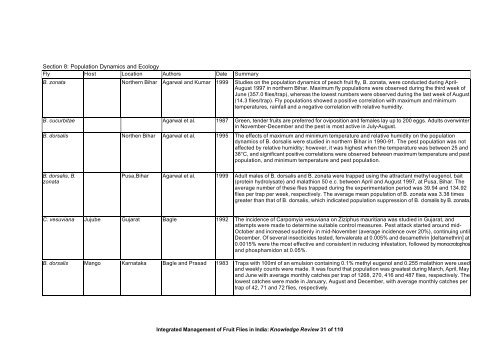“Key Informant Survey” of Production, Value, Losses and ... - DfID
“Key Informant Survey” of Production, Value, Losses and ... - DfID
“Key Informant Survey” of Production, Value, Losses and ... - DfID
You also want an ePaper? Increase the reach of your titles
YUMPU automatically turns print PDFs into web optimized ePapers that Google loves.
Section 8: Population Dynamics <strong>and</strong> Ecology<br />
Fly Host Location Authors Date Summary<br />
B. zonata Northern Bihar Agarwal <strong>and</strong> Kumar 1999 Studies on the population dynamics <strong>of</strong> peach fruit fly, B. zonata, were conducted during April-<br />
August 1997 in northern Bihar. Maximum fly populations were observed during the third week <strong>of</strong><br />
June (357.0 flies/trap), whereas the lowest numbers were observed during the last week <strong>of</strong> August<br />
(14.3 flies/trap). Fly populations showed a positive correlation with maximum <strong>and</strong> minimum<br />
temperatures, rainfall <strong>and</strong> a negative correlation with relative humidity.<br />
B. cucurbitae Agarwal et al. 1987 Green, tender fruits are preferred for oviposition <strong>and</strong> females lay up to 200 eggs. Adults overwinter<br />
in November-December <strong>and</strong> the pest is most active in July-August.<br />
B. dorsalis Northen Bihar Agarwal et al. 1995 The effects <strong>of</strong> maximum <strong>and</strong> minimum temperature <strong>and</strong> relative humidity on the population<br />
dynamics <strong>of</strong> B. dorsalis were studied in northern Bihar in 1990-91. The pest population was not<br />
affected by relative humidity; however, it was highest when the temperature was between 25 <strong>and</strong><br />
38°C, <strong>and</strong> significant positive correlations were observed between maximum temperature <strong>and</strong> pest<br />
population, <strong>and</strong> minimum temperature <strong>and</strong> pest population.<br />
B. dorsalis, B.<br />
zonata<br />
Pusa,Bihar Agarwal et al. 1999 Adult males <strong>of</strong> B. dorsalis <strong>and</strong> B. zonata were trapped using the attractant methyl eugenol, bait<br />
(protein hydrolysate) <strong>and</strong> malathion 50 e.c. between April <strong>and</strong> August 1997, at Pusa, Bihar. The<br />
average number <strong>of</strong> these flies trapped during the experimentation period was 39.94 <strong>and</strong> 134.92<br />
flies per trap per week, respectively. The average mean population <strong>of</strong> B. zonata was 3.38 times<br />
greater than that <strong>of</strong> B. dorsalis, which indicated population suppression <strong>of</strong> B. dorsalis by B. zonata.<br />
C. vesuviana Jujube Gujarat Bagle 1992 The incidence <strong>of</strong> Carpomyia vesuviana on Ziziphus mauritiana was studied in Gujarat, <strong>and</strong><br />
attempts were made to determine suitable control measures. Pest attack started around mid-<br />
October <strong>and</strong> increased suddenly in mid-November (average incidence over 20%), continuing until<br />
December. Of several insecticides tested, fenvalerate at 0.005% <strong>and</strong> decamethrin [deltamethrin] at<br />
0.0015% were the most effective <strong>and</strong> consistent in reducing infestation, followed by monocrotophos<br />
<strong>and</strong> phosphamidon at 0.05%.<br />
B. dorsalis Mango Karnataka Bagle <strong>and</strong> Prasad 1983 Traps with 100ml <strong>of</strong> an emulsion containing 0.1% methyl eugenol <strong>and</strong> 0.255 malathion were used<br />
<strong>and</strong> weekly counts were made. It was found that population was greatest during March, April, May<br />
<strong>and</strong> June with average monthly catches per trap <strong>of</strong> 1268, 270, 416 <strong>and</strong> 487 flies, respectively. The<br />
lowest catches were made in January, August <strong>and</strong> December, with average monthly catches per<br />
trap <strong>of</strong> 42, 71 <strong>and</strong> 72 flies, respectively.<br />
Integrated Management <strong>of</strong> Fruit Flies in India: Knowledge Review 31 <strong>of</strong> 110

















